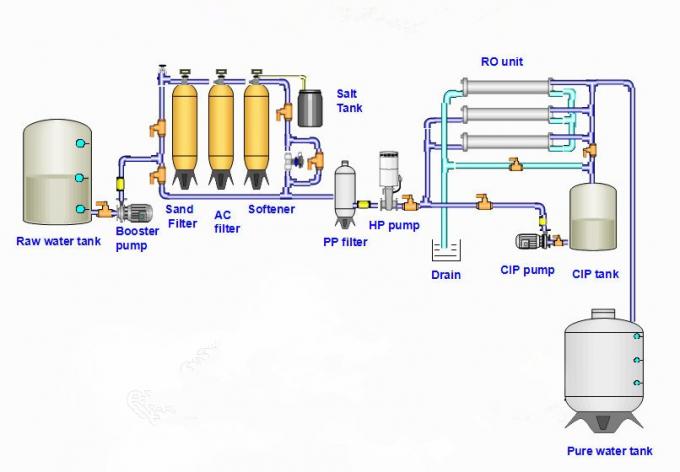By / Ahmed Hasham
Water & Quality Expert
https://www.linkedin.com/in/ahmed-hasham-01024b27/
Definition of Sanitization
Sanitization is not an absolute process. It is a partial removal of organisms. The sanitization process should reduce the organism population by some 90%. In water, sanitization is often defined as a 3-logarithm (log) or 1,000-fold reduction in the number of bacteria.
Sanitization tactics:
There are two basic tactics for controlling bacterial growing in a potable water system:
- The first tactic is to keep a constant residual level of biocide agent within the system (continuous dosing).
As example for this technique that water treatment facilities use when they inject sufficient chlorine to provide a residual throughout the distribution system.
- The second tactic is to periodically sanitize. If for some aim the process protocol not allows the use of continuous chlorination, then periodic sanitization will be essential.
Chemical Sanitization:
Chemical biocides can be divided into two main groups:
- Oxidizing: contain chlorine, chlorine dioxide, and ozone.
- Non-oxidizing: contain Quaternary ammonium compounds, formaldehyde, and anionic and nonionic surface-active agents.

This table provides some general information about biocides. The table includes recommended contact times for various concentrations, as well as factors to consider when choosing a biocide to use with automated watering systems. Note that some biocides are not recommended for use with automated watering systems at all.
Chlorine
The most common sanitizing agent is chlorine. Chlorine is the cheapest, most readily available, and is effective and easy to handle. Even though ozone and chlorine dioxide are also effective biocides, there is little understanding using these chemicals to sanitize automated water systems. The effectiveness of a sanitizing chemical depending on both concentration and contact time.
Typical sanitization of an automated water system is accomplished using 20 ppm chlorine for 30–60 minutes. Higher concentrations or longer soak times will increase effectiveness; however, do not use a sanitizing solution with a chlorine concentration higher than 50 ppm. Repeated sanitization at higher concentrations can cause corrosion of stainless steel wetted components in an automated watering system.
Thermal Sanitization using Hot Water
Heated water may be used to sanitize a system if it is held in the range above 70°C (158°F). The practical characteristics of handling water at this temperature (the materials of construction and the energy used).
Sanitization Frequency
Sanitization does not kill 100% of bacteria in a watering system, the remaining bacteria can re grow in the system. This means that the components of a water system will need to be re sanitized periodically.
The frequency for your particular system will depend on its design, the frequency of both flushes and filter changes, the supply water quality, and the bacterial quality you are trying to maintain. To determine the sanitization frequency, establish a regular schedule for drawing samples and monitoring the total bacteria count levels. Increase or decrease the frequency of sanitization based on the measured bacterial quality. To destroy an established biofilm, (for example: a watering system that has been in operation for some time and has never been sanitized) repetitive sanitizing cycles are usually required.
The initial chlorine contact may only kill the top sheet of biofilm. Chlorine will also destroy the glycocalyx or slime which is the “glue” that holds biofilm bacteria composed and to the pipe wall, this weakens the biofilm structure. For that reason, it is a great idea to follow chlorine exposure with a high-flow flush. Fresh chlorine is then injected again to the piping to kill the next bacterial layer. This chlorine sanitization/flush cycle may need to be repeated more than a few times on successive days till the gathered biofilm has been removed. For a well-established biofilm, 3-10 cycles may be need.
Sanitization of an Automated Watering System
All the components in an automated watering system should be sanitized at regular intervals. This section describes how to sanitize these components.
RO Units
Continuous chlorination for feed water:
For reverse osmosis (RO) systems using cellulose acetate membranes, continuous chlorine pretreatment is used to prevent bacteria growth in the RO machine. Chlorine injection is adjusted to provide 0.5 – 2.0 ppm of free chlorine in the feed water and a minimum of 0.3 ppm free chlorine.
Clean-in-place cycle for RO unit:
Regular cleaning of the RO machine is essential because contaminants can precipitate or scale on membrane surfaces, reducing flow rate and quality of the product water. On most of the RO machines, cleaning is done automatically on a periodic basis. Low pH cleaners (Such as citric acid) are used to remove precipitated salts and metals, and alkaline (Such as NaOH) or neutral cleaners are used to remove dirt, silt, and organic foulants.
RO membranes can also become fouled with microorganisms. To minimize biofouling, it is best if the RO machine can operate continuously, or as many hours a day as possible, to minimize stagnant downtime. If a microbiological cleaner is needed, follow the membrane manufacturer’s recommendations.
References:
Joymalya bhattacharya, Sanitization of automated watering system, Generation of pharmaceutical water. CreateSpace Independent Publishing Platform, 2013. — 134 pages, ISBN: 1492393495.






لا تعليق